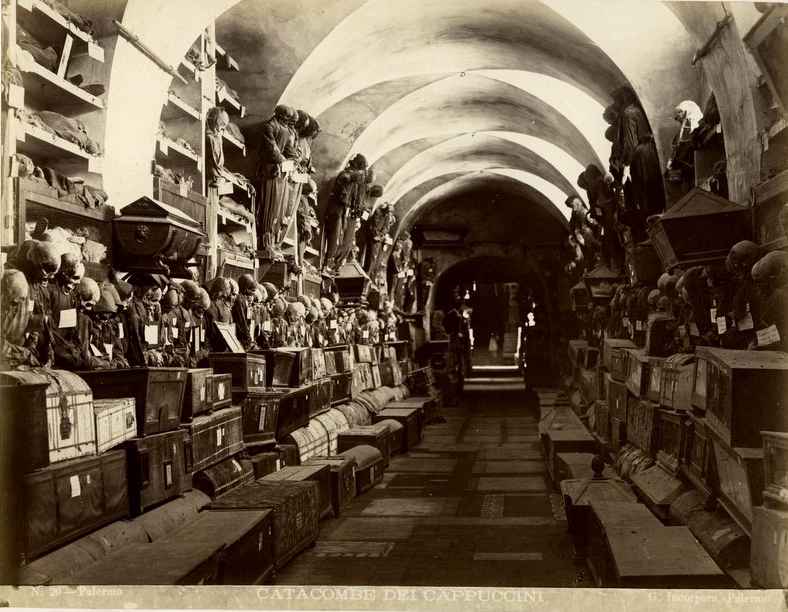For visitors to Palermo who enjoy the macabre and/or bizarre, the Catacombe dei Cappuccini
(Catacombs of the Capuchins or Capuchin Catacombs) are a must-see.
Like most displays of human remains, a visit to the mummies can lead to
reflection on the meaning of death. But it goes without saying that this
"human library" of thousands of bodies is not for the faint-hearted or
weak-stomached!
The corpses range in date from the late 1500s to 1920 and most were embalmed before their display. Giuseppe Tommasi, prince of Lampedusa and author of the famous Sicilian work The Leopard, was buried in the cemetery next to the catacombs in 1957.
In the 1940s, Allied bombs hit the monastery, destroying many of the mummies. The Capuchin Monastery (Convento dei Cappuccini) itself was rebuilt over the remains of the original medieval church in 1623 and was once again restored in the early 20th century.
The corpses are dressed in splendid clothes, now somewhat decayed, and occupy their own individual niches according to their social status. Many of the deceased wrote wills that specified the clothes in which to bury them, and some even asked to have their clothes changed over a period of time.
Many corpses are still remarkably preserved and some give the impression of enjoying a joke with their deceased friends. Others are not in such good shape, with horribly contorted, creepy faces and missing parts like jaws and hands.
The last corpse to be buried here was that of 2-year-old Rosalia Lombaro, who died in 1920. She is so well-preserved, she has been nicknamed "Sleeping Beauty."





History
In 1599, Capuchin monks discovered that their catacombs contained a mysterious preservative that helped mummify the dead. As a result, more than 8,000 Sicilians from all walks of life chose to be buried here.The corpses range in date from the late 1500s to 1920 and most were embalmed before their display. Giuseppe Tommasi, prince of Lampedusa and author of the famous Sicilian work The Leopard, was buried in the cemetery next to the catacombs in 1957.
In the 1940s, Allied bombs hit the monastery, destroying many of the mummies. The Capuchin Monastery (Convento dei Cappuccini) itself was rebuilt over the remains of the original medieval church in 1623 and was once again restored in the early 20th century.
What to See
Visitors can wander through the catacombs' dank corridors among the mummified bodies. The halls are divided into categories that include: Men, Women, Virgins, Children, Priests, Monks, and Professors (including the famous painter Velasquez).The corpses are dressed in splendid clothes, now somewhat decayed, and occupy their own individual niches according to their social status. Many of the deceased wrote wills that specified the clothes in which to bury them, and some even asked to have their clothes changed over a period of time.
Many corpses are still remarkably preserved and some give the impression of enjoying a joke with their deceased friends. Others are not in such good shape, with horribly contorted, creepy faces and missing parts like jaws and hands.
The last corpse to be buried here was that of 2-year-old Rosalia Lombaro, who died in 1920. She is so well-preserved, she has been nicknamed "Sleeping Beauty."

No comments:
Post a Comment